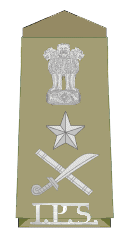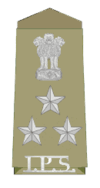Indian Police Service
| Indian Police Service | |
|---|---|
| Abbreviation | IPS |
| Agency overview | |
| Formed | 1948[1] |
| Preceding agency | Indian Imperial Police (1905-1948)[1] |
| Employees | 4730[2] |
| Legal personality | Governmental: Government agency |
| Jurisdictional structure | |
| National agency (Operations jurisdiction) | IND |
| Legal jurisdiction |
|
| General nature |
|
| Operational structure | |
| Elected officer responsible | Rajnath Singh, Minister of Home Affairs |
| Agency executives |
|
| Parent agency | Ministry of Home Affairs |
| Website | |
| http://mha1.nic.in/ips/ips_home.htm | |
The Indian Police Service (Bhāratīya Pulis Sevā) or IPS, is one of the three All India Services of the Government of India.[3] It has replaced the Indian Imperial Police in 1948, a year after India gained independence from Britain.
The service is not a force itself but provides leaders and commanders to staff the state police and all-India Central Armed Police Forces. Its members are the senior officers of the police.[4]
History
British India
In 1861, the British Government introduced the Indian Councils Act of 1861.[5] The act created the foundation of a modern and professionalised police bureaucracy in India. It introduced, a new cadre of police, called Superior Police Services, later known as the Indian Imperial Police.[5] The highest rank in the service was the Inspector General.[5]
In 1902-03, a Police Commission was established for the Police reforms under Sir Andrew Frazer and Lord Curzon.[6] It recommended the appointment of Indians at officer level in the police. Indians could rise only to the ranks of Inspector of Police, the senior N.C.O. position. However they were not part of Indian Imperial Police.[6]
From 1920, Indian Imperial Police was open to Indians and the entrance examination for the service was conducted both in India and England.[6]
Prior to Independence, senior police officers belonging to the Imperial Police (IP) were appointed by the Secretary of State on the basis of a competitive examination. The first open civil service examination for admission to the service was held in England in June 1893 and the ten top candidates were appointed as probationers in the Indian (Imperial) Police. It is not possible to pinpoint an exact date on which the Indian Police came formally into being. Around 1907, the Secretary of State's officers were directed to wear the letters "IP" on their epaulettes in order to distinguish them from the other officers not recruited by the Secretary of State through examination. In this sense, 1907 could be regarded as the starting point.[1] In 1948, a year after India gained independence; the Imperial Police was replaced by IPS.
Modern India
In 1972, Kiran Bedi joined the IPS, becoming the first woman IPS officer.[7]
Objective
The First Police Commission, appointed on 17 August 1865,contained detailed guidelines for the desired system of police in India and defined the police as a governmental department to maintain order, enforce the law, and to prevent and detect crime. The Indian Police Service is not a force itself but a service providing leaders and commanders to staff the state police and all-India Central Armed Police Forces. Its members are the senior officers of the police. With the passage of time Indian Police Service's objectives were updated and redefined, the current rules and functions of an Indian Police Service Officer are as follows:[8]
- To fulfil duties based on border responsibilities, in the areas of maintenance of public peace and order, crime prevention, investigation, and detection, collection of intelligence, VIP security, counter-terrorism, border policing, railway policing, tackling smuggling, drug trafficking, economic offences, corruption in public life, disaster management, enforcement of socio-economic legislation, bio-diversity and protection of environmental laws etc.
- Leading and commanding the Indian Intelligence Agencies like Research and Analysis Wing (R&AW), Intelligence Bureau (IB), Central Bureau of Investigation (CBI), Criminal Investigation Department (CID) etc., Indian Federal Law Enforcement Agencies, Civil and Armed Police Forces in all the states and union territories.
- Leading and commanding the Central Armed Police Forces (CAPF) which include the Central Police Organisations (CPO) such as Border Security Force (BSF), Central Reserve Police Force (CRPF), Indo-Tibetan Border Police (ITBP), National Security Guard (NSG), Central Industrial Security Force (CISF), Vigilance Organisations and Indian Federal Law Enforcement Agencies.
- To interact and coordinate closely with the members of other All India Services and with the Indian Revenue Service and also with the Indian Armed Forces primarily with the Indian Army.
- To lead and command the force with courage, uprightness, dedication and a strong sense of service to the people.
- Endeavor to inculcate in the police forces under their command such values and norms as would help them serve the people better.
- Inculcate integrity of the highest order, sensitivity to aspirations of people in a fast-changing social and economic milieu, respect for human rights, broad liberal perspective of law and justice and high standard of professionalism.
Selection
IPS officers are recruited from the state police cadres and from the rigorous Civil Services Examination conducted by Union Public Service Commission every year.[9]
The Civil Services Examination has a three-stage competitive selection process. At stage one, there is an objective type examination called the preliminary exam. This is a qualifying examination. It consists of a General Studies paper and an aptitude test. Only the candidates who pass this can appear for the "Main Examination" which consists of nine papers. Each candidate has to qualify a 2 languages paper and four general studies papers select an optional subject (two paper). This is followed by an interview.
After selection for the IPS, candidates are allocated to a cadre. There is one cadre in each Indian state, with the exception of three joint cadres: Assam-Meghalaya, Manipur-Tripura, and Arunachal Pradesh-Goa-Mizoram-Union Territories (AGMUT). Two-thirds of the strength of every cadre is filled directly by IPS officers and the remaining are promoted from the respective states cadre officers.
Eligibility conditions for Police Personals is defined by Govt recruitment laws. Each rank has different criteria which includes age limit, Education and Physical qualification. Once candidate satisfied all these criteria, he/she can take part in recruitment exam of Indian Police
Training
The training of IPS officer recruits is conducted at Sardar Vallabhbhai Patel National Police Academy in Hyderabad. The authorised cadre strength of Indian Police Service is 4920. (3270 Direct Recruitment Posts and 1650 Promotional Posts).[10] The Civil List of IPS officers is an updated (annual) list maintained by the Ministry of Home Affairs, Government of India that lists the posting details of all IPS officers in India. This Civil List can be accessed from this MHA site. It allows searching for an IPS officer on the basis of his name, Batch or Cadre.
Pay structure (gazetted officers) IPS
| Grade | Position in the State Government(s) | Salary (monthly) | Equivalent Position or Designation in the State Government(s) or Government of India (GOI) |
|---|---|---|---|
| Above Super Time Scale (Apex Scale) (After 30 years of service in IPS Cadre)[11] | Director of Intelligence Bureau or Director CBI in GOI, Commissioner of Police (State). | ₹2,25,000 (Entry Cadre) | Director General of Police – Number of Post differs from state to state; Director General or Special Director General in CAPFs, Secretary or Special Secretary (GOI) Chief Secretary of State. |
| Above Super Time Scale (HAG) (Pay-Band-4) (After 25 years of service in IPS Cadre)[12] | Special Commissioner of Police. | ₹67,000-₹79,000 plus grade pay of ₹12000 | Additional Director General of Police, Commissioner of Police (City), Special or Additional Director (GOI), Additional Director General in CAPFs, Additional Secretary (GOI) Principal Secretary of State. |
| Super Time Scale (Senior Administrative Grade) (Pay-Band-4) (After 18 years of service in IPS Cadre) | Joint Commissioner of Police | ₹37,400-₹67,000 plus grade pay of ₹10,000 | Inspector General of Police, Commissioner of Police (City), Inspector General of CAPFs, Joint Secretary (GOI) Secretary of State. |
| Super Time Scale (DIG/Conservator Grade) (Pay-Band-4) (After 14 years of service in IPS Cadre) | Additional Commissioner of Police | ₹37,400-₹67,000 plus grade pay of ₹8900 | Deputy Inspector General of Police, Commissioner of Police (City), Deputy Inspector General in CAPFs, Director (GOI)/ Principal Staff Officer (GOI). |
| Selection Grade (Pay-Band-4) (After 13 years of service in IPS Cadre) | Deputy Commissioner of Police (Selection Grade) | 37,400-INR67,000 plus grade Pay of ₹8700+ | Senior Superintendent of Police, Commandants of CAPFs, Director (GOI)/Sr.Principal Private Secretary (GOI) Special Secretary of State. |
| Junior Administrative Grade (Pay-Band-3) (After 9 years of service in IPS Cadre) | Deputy Commissioner of Police | ₹15,600-₹39,100 plus grade pay of ₹7600 | Superintendent of Police, Second-in-Command of CAPFs, Deputy Secretary (GOI)/Principal Private Secretary (GOI) District Collector/District Magistrate/Deputy Commissioner of a District, Joint Secretary of State. |
| Senior Time Scale (Pay-Band-3) (After 4 years of service in IPS Cadre) | Additional Deputy Commissioner of Police | ₹15,600-₹39,100 plus grade pay of ₹6600 | Additional Superintendent of Police, Deputy Commandants of CAPFs, Under Secretary (GOI) Addl. Collector/Addl. Magistrate/Addl. Deputy Commissioner of District, Deputy secretary of State. |
| Junior Time Scale (Pay-Band-3) (Initial Pay IPS Cadre) | Assistant Commissioner of Police | ₹15,600-₹39,100 plus grade pay of ₹5400 | Assistant Superintendent of Police, Assistant Commandants of CAPFs. |
Ranks and insignia
The standard uniform colour is Khaki.[13]
Ranks of the IPS
All State Police Services officers of and above the rank of Deputy Superintendent of Police (DSP) or Assistant Commissioner of Police (ACP) in State Police and Metropolitan Police forces respectively.[14]
- National Emblem above One star above Crossed Sword and Baton[16]
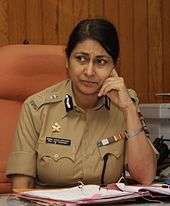
- National Emblem above Crossed Sword and Baton
- Commissioners of Police (State) or Director Generals of Police, States and territories of India
- Director Generals, Indian Intelligence agencies (Government of India)
- Director Generals, Indian Federal law enforcement agencies (Government of India)
- Director Generals, Central Armed Police Forces (Government of India)
- Secretary(ies) (R), Cabinet Secretariat, (Government of India)
- Special Commissioners of Police or Additional Director General of Police, States and territories of India
- Special or Additional Director Generals, Indian Intelligence agencies (Govt of India)
- Special or Additional Director Generals, Indian Federal law enforcement agencies (Govt of India)
- Special or Additional Director Generals, Central Armed Police Forces (Government of India)
- Special or Additional Secretar(ies) (R), Cabinet Secretariat (Government of India)
- One Star above Crossed Sword and Baton
- Joint Commissioners of Police or Inspector-Generals of Police, States and territories of India
- Joint Directors or Inspector-Generals, Indian Intelligence agencies (Govt of India)
- Joint Directors or Inspector-Generals, Indian Federal law enforcement agencies (Govt of India)
- Joint Directors or Inspector-Generals, Central Armed Police Forces (Government of India)
- Joint Secretar(ies) (R), Cabinet Secretariat, (Government of India)
- National Emblem above three stars in a triangle
- Additional Commissioners of Police or Deputy Inspector Generals of Police, States and territories of India
- Directors or Deputy Inspector-Generals, Indian Intelligence agencies (Govt of India)
- Directors or Deputy Inspector-Generals, Indian Federal law enforcement agencies (Govt of India)
- Directors or Deputy Inspector-Generals, Central Armed Police Forces (Government of India)
- Director(s) (R), Cabinet Secretariat, (Government of India)
- National Emblem above two stars
- Deputy Commissioner of Police (Selection grade) or Senior Superintendent of Police in selection grade with 13+ years of service (IPS officers posted in insurgency infested states such as J&K also wear this rank before 13 years of service to facilitate coordination and interaction with Commanding Officers of paramilitary and the Indian Army.[17]
- Deputy Secretary(ies) (R), Cabinet Secretariat, (Government of India)
- Other officers above selection grade
- Commandants in Central Armed Police Forces (Government of India)
- National Emblem above one-star
- Deputy Commissioner of Police or Superintendent of Police
- Under Secretary(ies) (R), Cabinet Secretariat, (Government of India)
- Commandant of State Armed Police Battalion
- Other officer on Junior Administrative Grade with between 9 and 13 years service
- Second-in-Command in Central Armed Police Forces (Government of India)
- National Emblem
- Additional Deputy Commissioner of Police or Additional Superintendent of Police
- Other officers on senior time scale with 9 years service or less
- Deputy Commandants of Central Armed Police Forces (Government of India)
- Three stars
- Assistant Commissioner of Police or Deputy Superintendent of Police
- Circle Officer (CO) in the states of Rajasthan and Uttar Pradesh
- Sub-Divisional Police Officer (SDPO)
- Assistant Commandant Central Armed Police Forces (Government of India)
- Two stars
- Assistant Superintendent of Police
- Indian Police Service officer probationary rank on 2nd year of service
- One-star
- Assistant Superintendent of Police
- Indian Police Service officer probationary rank on 1st year of service
Reforms
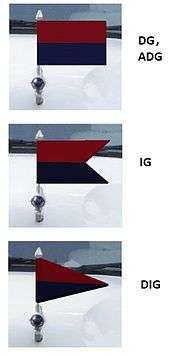
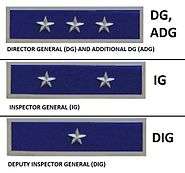
India's police continue to be governed by an archaic and colonial police law passed in 1861. The Indian Constitution makes policing a state subject and therefore the state governments have the responsibility to provide their communities with a police service. However, after independence, most have adopted the 1861 Act without change, while others have passed laws heavily based on the 1861 Act.
Repeated major incidents, (latest of them being 2012 Delhi gang rape) revealed failure of police to uphold the rule of law.[18][19]
The need for reform of police in India has been long recognised. There has been almost 30 years of debate and discussion by government created committees and commissions on the way forward for police reform, but India remains saddled with an outdated and old-fashioned law, while report after report gathers dust on government bookshelves without implementation. Many committees on police reforms have recommended major reforms in the police system coupled with systematic accountability.[20][21]
National Police Commission (1977-81)
National Police Commission was the first committee set up by the Indian government to report on policing. The National Police Commission began sitting in 1979, in the context of a post-Emergency India, and produced eight reports, including a Model Police Act, between 1979 and 1981.[22]
Ribeiro Committee (1998-99)
In 1996, two former senior police officers filed a Public Interest Litigation (PIL) in the Supreme Court, asking for the Court to direct governments to implement the recommendations of the National Police Commission. The Supreme Court directed the government to set up a committee to review the Commission's recommendations, and thus the Ribeiro Committee was formed. The Committee, under the leadership of J. F. Ribeiro, a former chief of police, sat over 1998 and 1999, and produced two reports.[22][23]
Padmanabhaiah Committee (2000)
In 2000, the government set up a third committee on police reform, this time under the stewardship of a former union Home Secretary, K. Padmanabhaiah. This Committee released its report in the same year.[22][24]
Malimath Committee Report (2003)
The Malimath Committee Report submitted in March, 2003 has very articulately laid down the foundation of a restructured and reoriented police system.[25] The Committee in its report observed that the success of the whole process of Criminal Justice Administration depended completely on the proper functioning of the police organisation especially in the investigation stage. Apart from the investigation of offences, the police also have the duty of maintaining law and order.
Soli Sorabjee Committee (2005)
In 2005, the government put together a group to draft a new police Act for India. It was headed by Soli Sorabjee (former Attorney General). The committee submitted a Model Police Act to the union government in late 2006.[22]
Supreme Court intervention (2006)
In 1996, Prakash Singh (a former Directors General of Police of the states of Assam and subsequently Uttar Pradesh and finally Director General of the Border Security Force) initiated a Public Interest Litigation (PIL) in the Supreme Court of India, asking the court to investigate measures to reform the police forces across India to ensure the proper rule of law and improve security across India. The Supreme Court studied various reports on police reforms. Finally, in 2006, a bench of Justice Y.K. Sabharwal, Justice C.K. Thakker and Justice P.K. Balasubramanyan[26] ordered the state governments to implement several reforms in police force.[27]
Several measures were identified as necessary to professionalise the police in India:
- A mid or high ranking police officer must not be transferred more frequently than every two years.
- The state government cannot ask the police force to hire someone, nor can they choose the Chief Commissioner.
- There must be separate departments and staff for investigation and patrolling.
ss,[28] which will include the creation of:
- A State Security Commission, for policies and direction
- A Police Establishment Board, which will decide the selection, promotions and transfers of police officers and other staff
- A Police Complaints Authority, to inquire into allegations of police misconduct.
Follow-up from Supreme Court
In 2006, due to a lack of action by all the state governments,[29] the Supreme Court ordered the state governments to report to it why the reform measures outlined were not implemented.[30] After being questioned in front of the judges of the Supreme Court, the state governments are finally starting to reform the police forces and give them the operational independence they need for fearless and proper law enforcement. Tamil Nadu Police has been in the forefront of application of the new referendum.[31]
Again, in October 2012, a Supreme Court bench of Chief Justice Altamas Kabir and Justices Surinder Singh Nijjar and Jasti Chelameswar asked all state governments and Union territories to inform about compliance of its September 2006 judgement. The order was passed when Prakash Singh through his lawyer Prashant Bhushan said that many of the reforms (ordered by the Supreme Court) have yet not been implemented by many state governments.[32]
Notable IPS Officers
Any assessment of a bureaucrat should be the change he/she has brought in the country. Below is the list of few officers who are one of them.[33][34][35][36]
See also
- Indian State Police Services
- Law enforcement in India
- Civil Services of India
- All India Service
- Indian Forest Service
- Indian Armed Forces
- Special Duty Allowance (SDA)
References
- 1 2 3 "Data History of Indian Police Service (Official Raj Govt. Page)". Retrieved 2010-04-26.
- ↑ "Ministry of Home Affairs: Annual Report 2011-2012" (PDF). Ministry of Home Affairs. Retrieved 17 May 2012.
- ↑ "IPS, IAS and IFS: All India Services (Government of India)" (PDF). Retrieved 2009-04-13.
- ↑ "Service Profile for Indian Police Service (IPS)" (PDF). Ministry of Home Affairs (India). 23 August 2016.
- 1 2 3 Shahidullah, Shahid M. Comparative Criminal Justice Systems. Jones & Bartlett Publishers, 2012. ISBN 9781449604257.
- 1 2 3 Alexander, K. Police Reforms in India: An Analytical Study. Discovery Publishing House, 2006. ISBN 9788183561280.
- ↑ "First woman IPS officer Kiran Bedi seeks voluntary retirement". Economic Times. 27 November 2007.
- ↑ "Duties and Responsibilities of Indian Police Service officers". UPSCguide.com. Retrieved 2009-12-19.
- ↑ "Awaaz India Pvt. Ltd – About Indian Police Service". Retrieved 2010-04-26.
- ↑ http://mha.nic.in/pdfs/ips_cadre_stren.pdf
- ↑ http://mha1.nic.in/pdfs/ProGuidPAR160410.pdf
- ↑ http://mha1.nic.in/pdfs/IPS-Guid-190710.pdf
- ↑ "Why is the colour of the Indian police uniform khaki?". The Times of India. 3 March 2007. Retrieved 2010-05-11.
- ↑ "Modern ranks and insignia of IPS and SPS Officers Bio". Retrieved 2010-01-20.
- ↑ Mumbai CP's post downgraded again from DG to ADG
- ↑ "Director, Intelligence Bureau's Insignia Equivalent to Armed Forces Generals". Government of India. Retrieved 2009-07-27.
- ↑ Indian Military : Service Benefits and Issues: Illegal (Police) badges of rank in J & K. Indianmilitary.info (2011-01-10). Retrieved on 2013-08-17.
- ↑ "Inept Delhi cops get HC rap". DNA. 21 December 2012. Retrieved 22 December 2012.
- ↑ "Two ACPs are suspended". The Hindu. Retrieved 28 December 2012.
- ↑ "Failure of governance root cause of crimes against women: Verma committee". The Hindu. 23 January 2013. Retrieved 23 January 2013.
- ↑ "Read: Highlights of Justice Verma Committee report". CNNIBNLive. 23 January 2013. Retrieved 23 January 2013.
- 1 2 3 4 "PRAKASH SINGH Case at LIIofIndia.org". Retrieved 12 April 2013.
- ↑ "Ribeiro Committee". Archived from the original on 6 Mar 2013. Retrieved 12 April 2013.
- ↑ "Padmanabhaiah Committee". Archived from the original on 6 Mar 2013. Retrieved 12 April 2013.
- ↑ Dutta, Mriganka Shekhar; Marico Baruah (1 January 2008). "POLICING THE NATION IN THE 21ST CENTURY : AN APPRAISAL OF THE PROPOSED REFORMS" (PDF). NUJS Law Review. Retrieved 3 January 2015.
- ↑ "Prakash Singh Case". Retrieved 12 April 2013.
- ↑ Prasad, Devika; Caroline Avanzo (5 November 2006). "Seize the opportunity". Chennai, India: The Hindu. Retrieved 2007-09-12.
- ↑ Strip, Mobius; Ramesh Ramanathan (7 May 2007). "Sohrabbudin's encounter: An article on Prakash Singh, IPS". The Wall Street Journal. Retrieved 2007-09-12.
- ↑ "COMPLIANCE WITH SUPREME COURT DIRECTIVES" (PDF). Archived from the original (PDF) on 6 March 2013. Retrieved 12 April 2013.
- ↑ "The Supreme Court of India takes the lead on police reform: Prakash Singh vs. Union of India". Retrieved 2007-09-12.
- ↑ Das, Sunrat (6 May 2007). "Board to lend ears to transfer woes". Retrieved 2007-09-12.
- ↑ "SC asks states to file affidavit on police reforms". Hindustan Times. 16 October 2012. Retrieved 16 October 2012.
- ↑ "10 Amazingly Dedicated Indian Civil Servants You Will Be Proud To Know". The Better India.
- ↑ http://buzz.iloveindia.com/the-best-ias-ips-officers-india-has-ever-seen.html. Missing or empty
|title=(help) - ↑ http://hillpost.in/2013/11/top-7-examples-of-indian-officers-taking-government-to-task/96850/. Missing or empty
|title=(help) - ↑ http://www.folomojo.com/indias-best-these-ias-officers-are-a-credit-to-the-service/. Missing or empty
|title=(help)
Further reading
- History of services of Indian police service, as on 1 July 1966, by Ministry of Home Affairs, India. Published by Govt. of India, 1969.
- The peace keepers: Indian Police Service (IPS), by S. R. Arun, IPS, DGP Uttar Pradesh. Published by Berghahn Books, 2000. ISBN 978-81-7049-107-1.
- The Indian Police Journal (IPJ), by Bureau of Police Research and Development, Ministry of Home Affairs. Published by Govt. of India, October–December 2009 Vol.LVI-No.4. ISSN 0537-2429.
- History of services of Indian police service, as on 1 July 1966, by Ministry of Home Affairs, India. Published by Govt. of India, 1969.
- Intelligence Bureau may get its first Muslim chief 'S Asif Ibrahim'
- Police reform and election reform need.
- Half cear reform
- police & people
- police reform cases
- Need of basic reform
- Reform too delayed
External links
| Wikimedia Commons has media related to Indian Police Service. |
